Puzzle games and their brain-tickling mechanics have become quite popular over the years for supposedly boosting brain power. Of course, I’m not really qualified to get into that argument, so let’s look at some of the best and most popular puzzle games out there instead.
While you might immediately equate puzzle games with the kind that you’d find on mobile devices, there’s actually a breadth of really deep, complex and philosophical puzzle games.
That’s not to say that you can’t find that on mobile platforms, I don’t want to be a gatekeeper, but you should certainly check out the offerings on PC, as you’ll find some of the best games in the genre. That being said, if you don’t have a desktop, you might check out some outstanding budget PCs.
#1 Portal 2
The quintessential puzzle game, no list like that would really be complete without Portal 2. Easily one of the best puzzle games out there, Portal 2 builds massively on Portal and throws you back into the figurative fire of Aperture Labs. Oh, also, the cake is a lie.
Of course, the original guns from the original game appear here, although the puzzles have become exceedingly more complex. Moving environments, pressure pads, bouncy paint, and a whole army of robots that absolutely don’t necessarily like you are there to make your life difficult. You also get to find out a lot about the actual world that Portal takes place in, with tons of backstory being filled in like there’s no tomorrow.

The great thing about Portal 2 is that the puzzles don’t usually make you feel like a dolt when you figure them out. Sure, there are some real complex puzzles in here, but for the most part they’re reasonably easily to suss out once you’ve got the spatial reasoning down.
The box of toys you get to solve puzzles with also helps a lot towards that goal, and sometimes it’s just a matter of finding the right execution, rather than trying to figure out an exceedingly complex puzzle. Equally important is the story, which really ties the puzzles together and engrosses you in the world. GLaDOS is constantly harassing and berating you, almost always driving you to move forward.
As mentioned, you also get to understand the purpose behind the facility, as well as origin stories for different characters, including the mysterious founder, and even GLaDOS herself. Accompanying you is Wheatly, a seemingly inept robot voiced hilariously by Steven Merchant which really just make the dialogue and world shine.
As you might expect, you can finish the game in single-player mode, but grabbing a partner and playing in co-op really adds to the fun. Picking up from where the single-player story ends, you and a friend get put in charge of a couple of robots and continue the story of Aperture Science.
The great thing with the co-op story is that it doesn’t just reuse environment and that’s it, but instead with the inclusion of a friend, you really have to approach puzzles in a different manner than you have in the single-player portion. I have to say though, even though the co-op story isn’t as big and doesn’t have as many characters, it’s a brilliant inclusion in a game that’s already excellent.
If you haven’t played Portal 2 then you’re sadly missing out on not only an excellent puzzle game, but just an awesome game overall. You’re in luck though, since the game is so cheap nowadays, you can easily grab a couple of copies, a friend, and get cracking on some of the most fun times you’re likely to have. Or you could find out the cake is a lie (see, I told you).
#2 The Talos Principle
In stark contrast to Portal 2 is The Talos Principle, a beautifully stark game that is all about the puzzles. While it doesn’t regale you with traditional action that you’d expect from other titles on this list, it’s outward appearance belays the deeper questions the game makes you think about. Yes, the environments are beautiful and engrossing, but those are just surface level in terms of what the game has to offer from an existential point of view.

Being born as a blank slate in a world that you know nothing about, a mysterious voice rings out of the ether and propels you to move forward and solve puzzles. This Eloheim, as he likes to call himself (Hebrew for “God” so draw your own conclusions), guides you through a variety of seemingly dead worlds that are alive with history, from Ancient Greece to Ancient Egypt.
On the way, you start to question who and where you are, and an incessant drive to solve the mystery eats you up from inside. The puzzles themselves are real head-scratchers, although not overly so, and they aren’t as easy or straightforward as Portal 2’s puzzles.
A lot of the times you’ll certainly feel that you’re at the end of your wits and really want to look up a guide or walkthrough, before you get your sudden ‘Aha!’ moment which really good puzzle games thrive in. It’s this environment of constantly pushing you to the edge that makes the puzzle element of the game so great, and with nearly 120 puzzles or so total, you’re going to get several hours out of it.
While solving these puzzles that involves lasers, shields and glyphs, you get to hear Eloheim tell his possibly unreliable story, as well as listen into audio journals and read information on computer terminals. The only real downside is that this really awesome narrative storyscape doesn’t necessarily always mesh with the puzzle element of the game, and often you’re propelled by the mystery, rather than the puzzles.
Of course, that’s not to say that the puzzles aren’t amazing in their own right, it’s just that they could have been integrated into the story in a more complete way.
Ultimately, I don’t want to talk too much about the story or the nature of the puzzles, as the journey of discovering all that on your own is just too much fun. If you’ve been on the fence about The Talos Principle, I would definitely tell you to pick it up and check it out, but only if you have around 20-30 hours to spare. That being said, if you regularly suffer from existential crises, you might want to skip this one.
#3 Braid
After you hear the beginning of Braid’s story, you might think that it’s just another take on the Super Mario games. Having lost your princess due to a mistake, you now have to go and get her back. Don’t be fooled though, you aren’t going to be running around and practicing your reflexes and dexterity, and you certainly won’t be jumping on any goombas (although you will jump on other enemies, so there’s a bit of a reference).
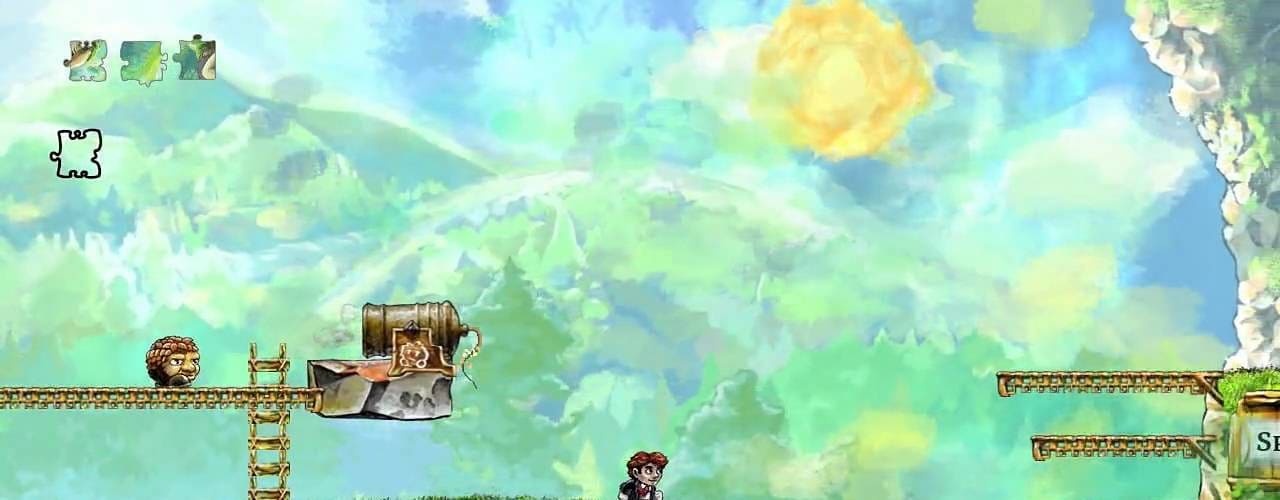
Instead, Braid is all about being methodical and thinking about what you need to be doing, and you’re always thinking a few steps ahead, almost like a game of chess. This is due to the way the puzzles are formed and the main mechanic of the game: time manipulation. Time forms a central part of almost every puzzle, with the mechanic evolving as you go through the different levels and different worlds.
At the most basic level, you can reverse time, which can help you avoid being killed or after accidentally jumping down the wrong rabbit hole. Of course, there are objects in the world which are immune to that reversal effect, and so you use those to solve the puzzle. In other worlds you’re given a shadow body double as it were, that repeats everything you previously did, so you can use it to jump on and get to a higher ledge.
In another world time reverses itself whenever you move in a specific direction. So it goes over the course of five worlds, each with its own time manipulation mechanics. Each level in each world also has a puzzle piece which you can collect that helps reveal the full extent of the story. You don’t have to collect all of them to finish the game, just the main 12, but you do if you want to get any sort of closure on the narrative.
Before closing out, I’d also like to mention that the hand-drawn art style is absolutely gorgeous. It isn’t overwhelming though, and it rarely gets in the way of the puzzles themselves. Similarly, the scoring is also excellent, with a distinct yet subtle sound that really brings the world alive.
While Braid is short, around six hours or so, it’s still a lovely and surprisingly exciting experience. The game doesn’t revolve around the ‘Aha!’ feeling as much as it allows you to just experience and interesting world and story through the puzzle solving. That’s not to say that puzzle are simple or easy, and you’ll certainly run into difficulties here and there, but for the most part you’re not going to be banging your head against the wall.
#4 World of Goo
Moving away from puzzle games with an underlying narrative, World of Goo is a bit more fun, laid back, and critical of corporate philosophy . . . yep. For the most part though, the game doesn’t really have a plot per se, but instead makes a statement about waste, corporate tracking and a bunch of other stuff through the puzzles themselves.
In the most basic sense, World of Goo is a physics puzzle game that makes you build structures, usually bridges, to get from one point to another. It does this using the eponymous goo itself, with about half a dozen varieties, each having its own quirks and unique aspects.

You win by getting the aforementioned go to a pipe that sucks them up, but you have to be smart about it, since some goo can’t be reused, and each level needs a certain amount of goo for you to complete it.
The first goos you run across are simple black ones that you can only use once, stretching them across nodes and hoping that you have enough. Then you have green goo, one of my favorites, that are reusable and can make life easier. Then there’s kissing good, flammable goo, stretch goo, there’s tons of different ones you get throughout the game each with unique quirks you need to overcome.
The real star of the game though are the levels themselves; weird, complex and yet simple, they’re the ones you have to contend with to get to the exit. While most of the puzzle revolves around spanning a gap, it’s more than just getting from point A to B, since the game likes to throw you for a loop.
For example, you might have to use balloons to stretch across a particularly long gap, or you might have to use the goo to move physical objects in the landscape so that you can get where you need to go.
Honestly though, one thing that I love about the levels, and World of Goo in general, is the artstyle. It’s somewhat cutesy with a manevelent slant to it which makes it a bit quirky and fun to spend hours in, especially when you aren’t frustrated. There’s also a bit of grotesqueness to the whole thing, something that mirrors the whole concept of corporate waste and overall distaste in the modern world (of 2008 when it came out).
The only really bad thing about World of Goo is that it’s short; around four worlds with 10 stages each, it should take you about five to six hours in total to go through. Oh, and the really awesome thing is that World of Goo was brought to the switch in 2017, so you don’t have to worry about playing a game that’s 11 years old on the PC, although it certainly holds up even if you do.
#5 Mini Metro
At first glance Mini Metro might not really seem like a puzzle game at all, but instead just your average day to day management/sim game. When looking deeper though, you begin to see the telltale signs of a really excellent, yet simple, puzzle game. Much like World of Goo, you won’t see the action of something like Portal 2, but instead enjoy a much more straightforward experience that still manages to excite you.
When you start out on each level, you are essentially looking at a top-down view of a map, all in white with no distinguishing features except for a station and maybe a river (or a few). Each station has a specific geometric shape with passengers that have destinations to other specific geometric shapes. You’re job is pretty simple: connect the stations together in a rail in such a way that passengers can get to their destinations.
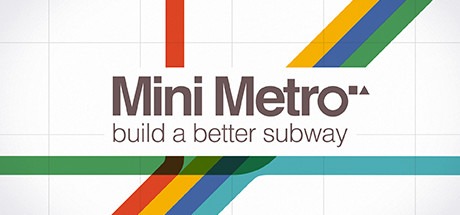
It sounds simple, and for the most part it is, but the complexity begins to scale up as you play. You see, as time passes, new stations get built, and you have to reassess and re-establish your line structure in a way that includes these stations.
Problem is, each station can only have so many lines going in, and not only that, but you also only have so many trains. If the number of passengers in a station pile up to full for more than 45 seconds, you lose the game.
The bigger issue here is that sometimes you have to cross a river by building a tunnel and you don’t really have an endless supply of those either. Thankfully, once every week you get to choose an upgrade, whether it be an extra tunnel, an extra train, an extra carriage or an extra line. So you do have some ability to keep up with demand, it’s just a matter of constantly rebuilding your lines and strategically placing your assets to keep demand satisfied.
Of course, it doesn’t necessarily end there, and the maps themselves also add another level of challenge to a puzzle that ramps up with difficulty as you play. Across the 13 maps that come with the game, each has its own unique traits that therefore create a unique challenge. One map might have trains that hold fewer passengers, whereas other maps, like Tokyo, provide you with a fast bullet train that mimics real life.
The real thing to be prepared for though is that there’s never really. Also, if you really want to test your mettle, you can try out Extreme Mode, where your choices are permanent and you can’t move around lines.
Mini Metro is a charming little game akin to World of Goo with a very minimalist feel that focuses almost completely on the puzzle of getting people around. While it did originally launch as a test for browsers, it’s made its way to PC and even smart phones, so you can play the transport puzzle game while riding public transportation as well. If that isn’t transportception, I’m not sure what is.
#6 The Witness
If you liked Braid then you’ll probably like The Witness, a game made by the same developer Jonathan Blow. That being said, it’s a vastly different game than braid in terms of the puzzles themselves, yet the cerebral, head-scratching aspect remains. There won’t be any combat or enemies here, just you and your own ability to solve puzzles.
In a way, the puzzles in The Witness are cumulative, rather than individual puzzle pieces that you solve and just go to the next one. The reason for that is that all the puzzles revolve around drawing lines on a grid . . . that’s literally it. As simple as it sounds though, the key to solving these puzzles isn’t always obvious, and not because the puzzles are illogical, but because the information requires a little bit of looking around on your part.
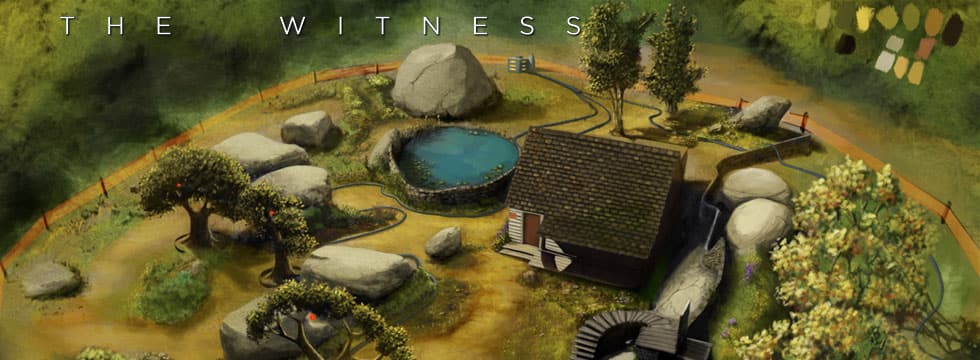
That’s really what The Witness offers, a mesh of both puzzles and exploration, which is evidenced the most with the very first puzzle you run into. Coming on the grid you need to solve, you might stand there for a while being stumped, not really knowing what to do or what the next step is.
This is where the game encourages you to explore a bit, because just a few seconds of walking nearby, there’s a signpost which gives you the information you need to solve the previous puzzle. While at first glance this may seem exceedingly tedious, the truth is that the beautiful environment and island that you’re on just begs to be explored.
The game doesn’t want you to sit and be stumped over a puzzle; instead, if you can’t solve it, just stop and do some exploring because you’re likely to find your answer when you do. Given the immense variety of locations and size of the island, you’re pretty much always seeing something new, and the island itself becomes the biggest puzzle.
Even though there’s really no story per se, there are hidden audio files which help fill in the gaps, along with whatever information each puzzle might abstractly divulge. That being said, there’s no real or true conclusion to things, and there’s no grand mystery that gets resolved, like it might in The Talos Principle.
That’s probably one of the bigger shortcomings of The Witness, that this amazing landscape wasn’t taken advantage of to tell a bigger story. Nonetheless, The Witness provides and engaging and compelling gaming experience that at times can be frustrating, but mostly is a zen experience.
The departure from traditional puzzle-solving that requires you to solve a puzzle before moving on is a breath of fresh air in a world where puzzles can drive you to hair-pulling frustration. With around 700 puzzles to do, you’re going to get dozens of hours out of what would otherwise be a pretty simple puzzler.
#7 Unravel
You shouldn’t really approach Unravel as a sort of pure puzzle game, but instead look at it from the perspective of a platformer with puzzles and story elements. The reason I say this is because when you boil the puzzle aspect right down to its core, the mechanics are pretty simple and fail to really go anywhere in the longer run.
That being said, the puzzles aren’t by any means boring or bland, and the length of the game at around five or six hours is just the right length so that you don’t get a bit too fatigued by the game. The first thing I’d personally talk about is the graphics and the environment that you find yourself in.
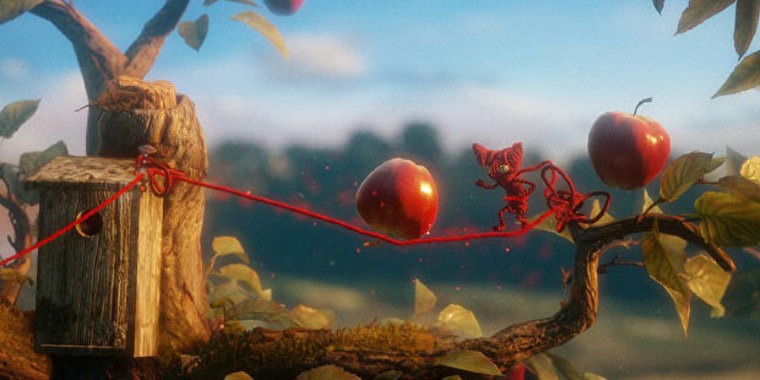
You play as Yarny, the main character and what is essentially a yarn doll momento that has come to life. As such, you’re basically always viewing the world in the micro scale from about ankle height, and boy is it an incredibly detailed world. When a Yo-yo is your size and a can of soda is a hill you need to climb, you really begin to appreciate the different scales and perspectives of our world.
The level of detail is just that stunning, but it follows through to Yarny itself, a vibrantly expressive little doll that can’t really even speak. Yarny is always amazed or excited about things, and the little animations here and there that hint at its current feelings are very convincing. Put Yarny and the world together, and you get something that always feels alive and moving.
Of course, as you can tell from the title, Yarny itself is the catalyst of the puzzles, with the yarn that he is made of serving as the base mechanic of the game. As you move along, a string of yarn unspools from Yarny, which you can use to do a variety of things, such as pull objects, attach to a ceiling and swing across a gap, or even create a little bridge to cross.
You need to be careful though, because that Yarn is finite and the only way to get it back is to backtrack or undu things that you had done before.
This is where the game begins to falter, as there’s very little room for error in a game that is mostly trial and error. While there are balls of yarn strewn across the world that you can use to sort of ‘refill’ Yarny, you’re still forced to backtrack from time to time when you realize that your solution to the puzzle is wrong.
Another slightly annoying thing is that the physics can sometimes not be consistent with itself, which can make some puzzle solving frustrating and time wasting. All that being said, Unravel is still very charming and fun, and all the frustrations go away when you just sit down and play to experience the world along with Yarny.
While there is a story I won’t really go into it, suffice to say that you collect memories of your life before you wake up, which fills in photos in an album. These photos tell the story of the family that had you, and I’ll stop there so as not to spoil anything. Oh, and luckily enough, there’s also an Unravel 2 out now, so you can get two games worth of Yarny and it’s antics.
#8 The Room Franchise
So far, all the games on this list have been a mix of puzzle and some other genre or element, such as action, or platforming. The three games in The Room franchise are completely the opposite, being almost completely pure puzzles with a very faint plot told through a series of notes you find as you play. Oh, and don’t worry, this franchise has no relation to the Tommy Wiseau movie of the same name (thankfully).
In the first game, the majority of the puzzle revolves around puzzle boxes, placed in some unknown and strange location, that you have to solve through. It’s never as simple as it seems though, and each box has more and smaller internal puzzles that you also need to solve before you’re able to move to the next one. A lot of the puzzle solving here revolves around observation, of the puzzle boxes and the environment itself.
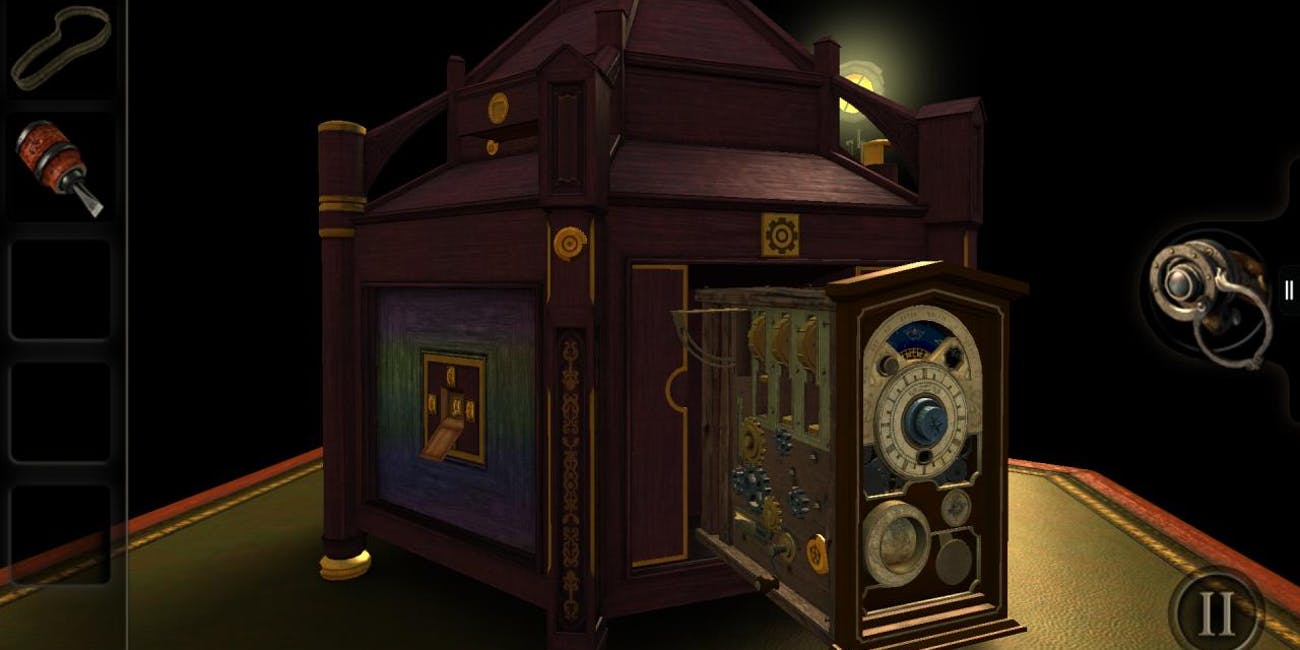
To that end, you get introduced to the lens, a handy little gadget that allows you to see things that you wouldn’t ordinarily see. It is through this lense you’ll also see other types of puzzles, such as beem aligning ones, and of course the greatest puzzle; notes that explain what the heck is going on. Of course, nothing is very clear on the plot, with you following a mysterious A.S. in their search for the Null Element.
The Room Two actually takes a departure from the puzzle-box in a puzzle-box approach and makes the puzzles a little bit more dynamic and organic. That’s not to say that the overall puzzle pieces aren’t complex and have internal puzzles of their own, it just means that they take the form of different object rather than a straight up box.
There’s also a lot more variety in environments with add to the mysterious atmosphere of the game; sometimes you’ll be in a boat, sometimes you’ll be in a seance parlor.
There’s also an uptick in the story elements, making it a bit more exciting and adventurous to push on through, although the focus is still in the puzzles. Again, you follow the mysterious A.S. on their journey to find the Null Element, discovering more about both as you go along. The Room Two is actually a bit longer than the first, at around 10 hours, so if you have a free day and want to get your mind working, this is a great game to do that with.
The Room Three then is the final in the franchise, essentially closing off the story while taking the puzzles to even higher heights. A lot of the puzzle designs from the first two games come back, including an upgrade in the form of a new lens which actually lets you see inside puzzle pieces.
The environments are still excellently crafted, with varied worlds each providing different types of puzzles and a pyramid which you slot into the home node, an actual mansion.
You also discover more The Craftsman, their relation to A.S. and get to a final conclusion to the whole franchise . . . sort of. While the game does have a default ending, there’s also three additional hidden endings which gives you more lore and a different form of closure to the franchise.
While The Room franchise may seem simple at first glance, it’s actually a complex and beautifully constructed puzzler game that doesn’t fuss or muss about with too much plot or action. The games are also on a bunch of different platforms; PC, Android, iOS, and Switch, so you have a variety of options to pick from if you want to play the game, although I’d say the PC version is probably the best.
#9 The Turing Test
When you first see The Turing Test, you might think that it’s some weird Portal knock-off, but reality couldn’t be further from the truth. While Portal has its unique humor that we all expect, The Turing Test is more sombre, and deals with some philosophical questions about existence and what it means to be human. Similarly, the puzzles are not as flexible as Portal and they tend to be more mechanica and step-by-step in nature.
The game does shine through the story though, with you playing as Eva, an astronaut that’s just been awakened from cryosleep in a spaceship above Europa, one of Jupiter’s moons. The AI on-board the ship, and your companion in the game, informs you that, surprise surprise, there’s a terrible disaster going on and that you’ve lost connection to the base station on the surface of Europa.
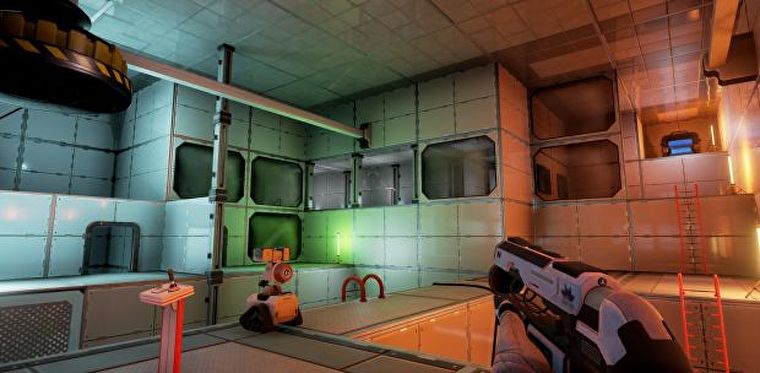
So, you pick up your handy utility gun that allows you to transfer energy balls from one object to another, drop yourself down on the surface of Europa, and enter the facility to figure out what exactly is going on.
The facility itself is stark, white and clinical in nature, with an almost eerily pristine look to it that belays something darker underneath. In a way, the majority of the puzzle solving in The Turing Test revolves around the environment, and you end up having to figure out how to get around the facility on to the next point.
As you do, the AI narrative gives you hints and story-bits, starting out being informative and helpful, and then devolving into something much more sinister(ish). As I alluded to earlier, the puzzles themselves are very mechanical in nature, and essentially only have one way of being solved, so there isn’t that freewheeling aspect you find in other games.
Similarly, and to its detriment, the puzzles in The Turing Test tend to be more about dexterity and physically moving around a space, than they are about creative problem solving. This can get a bit frustrating as the game goes on, and certainly the mid-point of the game is the slowest and most tedious.
If you push on through though, you’ll find yourself in the last act of the game, that not only has an incredibly enjoyable twist (which I won’t spoil), but also takes the puzzles you’re used to and turns them on it’s head. This is where I think the game really works against itself by giving a lul in the action and story, so to speak.
That being said, even in the second act there’s lots of environmental storytelling for you to sink your teeth into and come to your own conclusions.
While The Turing Test falters a bit here and there, overall it’s an excellent puzzle and gaming experience. The puzzles, while mechanical, still tease your brain, and as convention turns to revolution in the last third of the game, you’re sent off with a bang, rather than a frustrating whimper. Certainly worth a buy, especially if you enjoy games with a cerebral plot.
#10 TIS-100
TIS-100 is a weird game that actually sits perfectly within Zachtronics other set of games such as SpaceChem and Infinifactory. If you’ve ever played a Zachtronics game before, then you’ll probably know what sort of challenge you’re going to be in for. . . poor you.
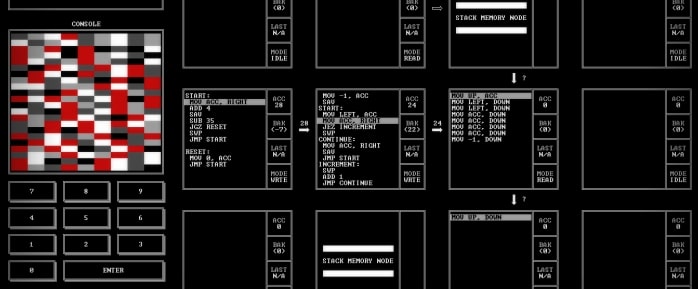
TIS-100, or Tessellated Intelligence System, is a machine that seems to be from the 70’s or 80s that you’ve happened upon. A malfunctioning device, you are set upon to solve puzzle through assembly level language, using a series of nodes that you can run functions with. A large part of that problem solving relies on the manual that comes with the game, and that you’re actually encouraged to print out and keep next to you as a reference guide.
As you can imagine from that description, TIS-100 is an entire and complex puzzle game based off programming, with a very loosely based plot. As you progress through the puzzle segments, you are presented with increasingly harder and harder programs to create. What makes TIS-100 stand out from other games though, is that you don’t need to unlock any tools as you progress, but instead are given everything through the manuals.
In a way that’s a double-edged sword, since on the one hand it’s a nice and refreshing change from games that lock progression through milestones, but on the other it doesn’t really give you any stand-out feeling of progression on it’s own. Nonetheless, solving frustrating puzzles is a reward of its own in a game that is constantly throwing you complex curve balls.
That being said, I would have still liked to see a bit more visual feedback on success or just in general, rather than just numbers and the barebones screen. Even so, TIS-100 is probably the pinnacle of puzzle-solving games in terms of difficulty, so if you really want a challenge for yourself, this is the one to go for.
Conclusion
So there you have it, a surprisingly varied group of puzzle games that should absolutely scratch every brain-tickle you have. What’s even better is that most of these games are a few years old now, so you can probably find them pretty cheap compared to how much they would have originally cost.
But hey, if these puzzlers don’t tickle your brain, why not check out some of the best strategy games around to work that brain, or maybe the best simulation games will interest you more.